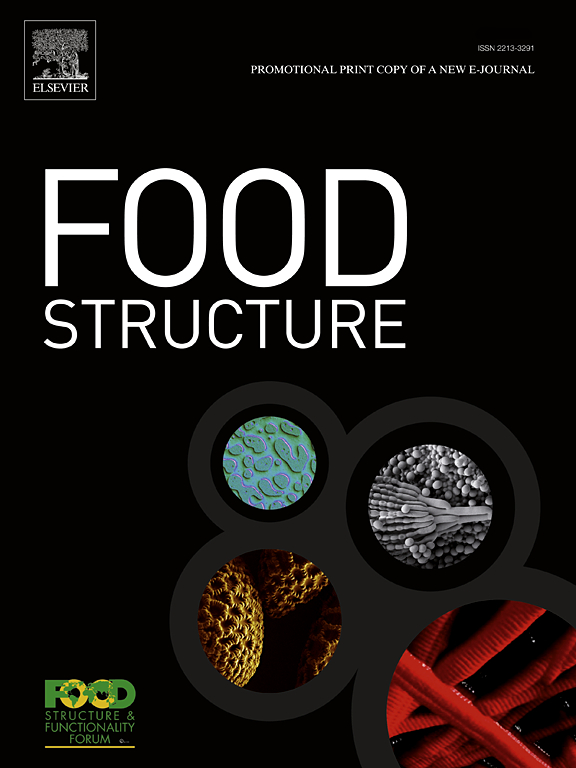多汁之路:结构孔隙的作用及其对植物性肉类汉堡感官和质地特性的影响
IF 5.9
3区 农林科学
Q1 FOOD SCIENCE & TECHNOLOGY
引用次数: 0
摘要
脂肪在决定植物性肉类的感官质量方面起着至关重要的作用。本研究调查了不同的脂肪掺入方法(无脂肪、液体油和固体脂肪颗粒),不同的固体脂肪体积(10 ~ 130 mm³)如何影响植物性和动物性肉类汉堡的感官特性。采用了包括感官评估、纹理测量和微观结构分析在内的综合方法。结果显示,动物基肉类(ABM)和植物基肉类类似物(PBMA)样品之间存在显著的感官差距:与PBMA样品相比,ABM样品表现出更均匀的脂肪分布,并且在初始多汁性、密度、黏结性硬度方面具有更高的感官评分属性。训练有素的小组成员还可以根据其油掺入方法将PBMA和ABM样品分为三个感觉簇。感官结果表明,随着固体脂肪颗粒体积的增大,初始多汁性和油性分数降低。蒸煮损失和微计算机断层扫描结果表明,PBMA样品形成了更多的气孔,这是油在蒸煮过程中逸出的途径,导致油的均匀分布较差。然而,尽管固体脂肪颗粒大小发生了变化,但ABM的坚固结构保留了脂肪,形成了更精细分布的“脂肪池”。该研究为制造商控制PBMA以获得理想的感官结果提供了见解。本文章由计算机程序翻译,如有差异,请以英文原文为准。
The path to juiciness: The role of structural pores and their impact on sensory and textural properties of plant-based meat burgers
Fat plays a crucial role in determining the sensory quality of plant-based meats. This study investigated how different methods of fat incorporation (no fat, liquid oil, and solid fat particles), with varying solid fat volumes (10 ∼ 130 mm³), contribute to the sensory properties of plant-based and animal-based meat burgers. A comprehensive approach encompassing sensory evaluation, textural measurements, and microstructural analysis was employed. The results revealed a significant sensory gap between animal-based meats (ABM) and plant-based meat analogues (PBMA) samples: ABM samples exhibited a more uniform fat distribution and were closely associated with higher sensory score attributes for initial juiciness, density, cohesiveness firmness compared to their PBMA counterparts. Trained panellists could also classify PBMA and ABM samples into three sensory clusters based on their methods of oil incorporation. The sensory results showed that initial juiciness and oiliness scores decreased as solid fat particle volume increased. Cooking loss and micro-computed tomography results indicate that PBMA samples formed more air pores, which acted as pathways for oil to escape during cooking, leading to a lesser uniform distribution of oil. However, the robust structure of ABM retained fat to form more finely distributed “fat pools” despite changes in solid fat particle sizes. This research offers insights for manufacturers to control PBMA for desirable sensory outcomes.
求助全文
通过发布文献求助,成功后即可免费获取论文全文。
去求助
来源期刊

Food Structure-Netherlands
Chemical Engineering-Bioengineering
CiteScore
7.20
自引率
0.00%
发文量
48
期刊介绍:
Food Structure is the premier international forum devoted to the publication of high-quality original research on food structure. The focus of this journal is on food structure in the context of its relationship with molecular composition, processing and macroscopic properties (e.g., shelf stability, sensory properties, etc.). Manuscripts that only report qualitative findings and micrographs and that lack sound hypothesis-driven, quantitative structure-function research are not accepted. Significance of the research findings for the food science community and/or industry must also be highlighted.
 求助内容:
求助内容: 应助结果提醒方式:
应助结果提醒方式:


